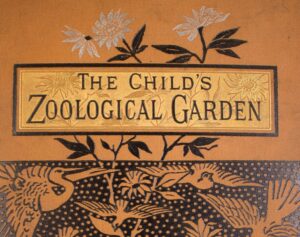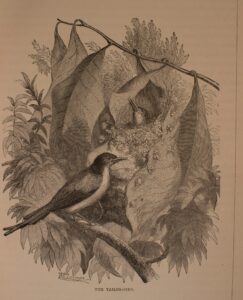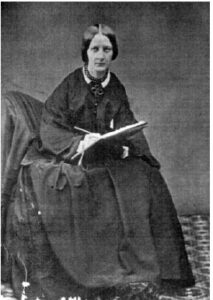Our hours spent happily in the Museum of Childhood’s archive revealed the richness of its collection of nature and science books written for young people, and confirmed the magnitude and diversity of women’s writing for children. Both elements will be on show in the Museum’s forthcoming exhibition, Growing Up With Books, which opens on June 1st!

But they are strikingly combined in a very particular mode of writing — one which combines a flourishing culture of science writing for children and young people in the c19th century with the creative and intellectual interests of women in scientific developments. Beatrix Potter is not alone in being a children’s writer with a keen fascination for natural science.
This was crystallised one day when we picked up a book called The Seasons written by a woman called Jane Marcet, first published in 1832. Though its familiar-sounding title might echo Romantic literature, this is in fact a collection of stories intended for ‘very young children’ . These present a world in which nature unfolds through the year’s natural cycle in active and participatory ways for the volume’s fictional child protagonists who are a boy called Willy and his sister Ann. Encouraged by his mother — ‘You must open up your eyes, Willy, and observe as well as you can’ — the child peers inside a bud picked from a horse-chestnut tree.
In another chapter, a little mouse intrudes through a hole in a corner of the nursery to enchant Willy at first, then to provoke him to ‘tantrums’ when the terrified housemaid suggests feline intervention! A fairly happy compromise for all is reached by the end – but along the way the story suggests that children’s sympathy for, and kindness towards, animals should be combined with respect for their natural instincts and habitats. It implies a rhythm and harmony existing both within nature and the domestic order which even the nicest of little mice shouldn’t disturb.
Such miniature nature narratives are sprinkled with a dose of moral conservatism. But they also try to teach their young readers to engage in close and empirical observation of the creatures, plants, and living things which encompass their world. The children’s curiosity leads them to discover everyday lessons about physiology, botany, the weather, and even the redness of robin feathers…
Jane Marcet (1769-1858) passionately believed that science should be made accessible. With her husband, a medical graduate of Edinburgh University, she belonged to a scientific and intellectual community which had diverse creative and educational interests. She knew Maria Edgeworth, novelist, educationalist, and children’s writer (the Museum archive holds a number of her books), and the extraordinary Mary Sommerville — the scientist, mathematician, and astronomer who came from the Borders and spent her girlhood in in Fife and Edinburgh.

As her extensive publications attest (such as the Conversations on Chemistry which took place between a teacher and her two female students), Marcet believed in the democratisation of knowledge. Her books reached a variety of readerly communities who usually suffered from various forms of social and cultural exclusion — children and young people; women; members of mechanics’ institutes. And they were famously read by a youthful Michael Faraday when he worked as an apprentice bookbinder.

Marcet seemingly turned to writing for children and young people later in life. Ever mindful of the potential dullness of any subject, she enriched a grammar book by references to fairy tales and sponge cakes! For her younger readers, her enduring aim was to make science ‘familiar’. This intimacy can be seen in The Seasons where the child-worlds of garden and home become a playground for scientific revelation, and the mother is portrayed as a figure of learning as well as nurture.
In one way, this might be construed as a way of ‘talking down’ to children yet in another as simultaneously respecting and expanding a child’s worldview. Whilst obviously very different in form and style, one can see a connection between her work and Hans Christian Andersen’s fairy tales which so vividly convey a sense of wonder and life in natural things. [As demonstrated above in SELCIE’s banner image, taken from the botanically-themed front cover of an Andersen edition!]

And it also brings to mind the beautiful nature illustrations of Jemima Wedderburn (1823-1909), the Edinburgh-born artist, ornithologist, children’s illustrator, and constructor of scientific toys.
In such ways, then, a single book chanced upon by the SELCIE team in the Museum archive opens up a world of interconnecting skeins between scientific creativity, children’s books, and the women who were so frequently their makers and illustrators.
This post written by Sarah
Further reading
Debbie Bark, ‘Science for Children’, in The Routledge Research Companion to Nineteenth Century British Literature and Science, edited by John Holmes and Sharon Ruston (2017)
Elizabeth J. Morse, ‘Jane Haldimand Marcet’, Oxford Dictionary of National Biography.
Kathryn A. Neeley, Mary Somerville: Science, Illumination, and the Female Mind (2001)
‘Jane Marcet’, Science History Institute, https://www.sciencehistory.org/historical-profile/jane-marcet
The Biographical Dictionary of Women in Science. Pioneering Lives from Ancient Times to the Mid-Twentieth Century, edited by Marilyn Ogilvie, Joy Harvey and Margaret Rossiter (2000)



Precious collection! I´m amazed to see these trend-setting, creative women embrace such broad perspectives at the time of educating children. Thank you for your article.
Best wishes.
Thank you so much! These women were brilliant, and their talent and creativity deserves to be much better known. Sommerville is recognised but so many of her contemporary writers and artists still remain relatively hidden in the shadows of cultural history. We’re glad that SELCIE’s work helps to give them a little bit more visibility! And shows again how the history of children’s literature unlocks so many doors!
A fascinating post! Jane Marcet is a great figure in Victorian History of Science. Glad you spot this.
We have an expert, Ruth Watts in Martineau Society, who is fairly familiar with the subject! How about the long awaiting 19th Scottish Children’s Book?
Shu-Fang
Thank you so much – and the book is on its way!
So interesting to read this: it is further evidence that children’s nonfiction literature has a long tradition of bringing together creativity, science and imagination which is still seen in some of the best contemporary examples.
Thank you so much for your comment – it’s a really vivid way of communicating with children and, as you say, persists today. Please do come to our exhibition if you can make it!